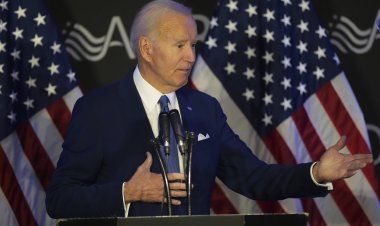Misunderstandings About Men Plague Both Political Parties (Editorial)
Reactionary forces can exploit male grievances, but there is an effective method to counter this.

With the election just a few weeks away, the race for male voters is becoming increasingly competitive. While young women appear firmly aligned with the Democrats, young men remain more undecided, and the Trump-Vance ticket is making strides, evidenced by some polls that suggest a double-digit lead among this demographic.
Ironically, an election initially focused on women's issues due to the debate over abortion rights may ultimately come down to the votes of young men.
From the outset, Republicans have actively sought the male vote. Donald Trump was introduced at the RNC convention by UFC head Dana White, and Hulk Hogan made a memorable appearance as well. The GOP's message was clear: they appeal to the interests of men and embrace traditional masculinity. Trump and JD Vance have featured prominently on various podcasts popular with young men, and efforts to encourage Republican voter turnout are being promoted at college football games.
In response, Democrats are now trying to catch up. Kamala Harris has rolled out an “opportunity agenda” tailored for Black men, with promises to support entrepreneurship, regulate cryptocurrency, and recruit more male teachers. Reports suggest she may consider guesting on Joe Rogan’s podcast, which boasts a substantial male audience. It seems Democratic strategists have recognized the challenge of securing votes without the support of men. The pressing question is whether they are acting swiftly enough or if it's too late.
Meanwhile, there lies a policy paradox that the Democrats could potentially leverage. Republicans are advocating a pro-male stance yet lack substantive policy proposals. In contrast, Democrats have existing initiatives that could lay the groundwork for a robust pro-male policy platform but have been cautious about framing them as such. They could do much more.
A significant opportunity exists for a party to develop an agenda that resonates with men and addresses their genuine concerns.
Contrary to progressive assumptions, young men are not morphing into a cohort of misogynists. In fact, gender equality support is on the rise, even among men under 30. The issue appears to be that many men feel their identities and concerns are overlooked by the political left.
If the Democrats are perceived as the “women’s party,” as noted by a party strategist, it’s understandable that men may look elsewhere. While women are prominently included in their platform, men are notably absent. The newly established Gender Policy Council in the White House has yet to tackle any issues specifically concerning boys or men.
Neglecting men’s issues has proven to be a costly oversight in the political and cultural arenas. The challenges many men face, particularly working-class men and men of color, are not mere fabrications of the online “manosphere.” They are substantial challenges that have often gone unacknowledged. This neglect has created space for more reactionary narratives to fill the void.
When issues are ignored, they fester into grievances that can be exploited for reactionary purposes. The straightforward remedy is clear: Do not overlook these problems.
Both political parties err in viewing gender equality as a zero-sum game; that addressing the needs of boys and men detracts from supporting girls and women. There remains ample work to be done for women and girls, extending beyond matters of healthcare: investing in the care economy to assist working mothers, increasing female representation in critical fields like technology and politics, modernizing career pathways to mitigate the “parenting penalty,” and breaking down barriers for women entrepreneurs in accessing capital, among other initiatives.
However, advocating for women does not necessitate sidelining men. In reality, the interests of both genders are not in opposition, despite cultural rhetoric suggesting otherwise. Numerous progressive young women are concerned about their brothers' mental health and their husbands' career prospects. A thriving society for women cannot be built on the struggles of men.
There is still a chance to establish a clear policy agenda for boys and men across key areas like health, education, and family life. Doing so would send a strong message to male voters: We recognize you. We understand your challenges and are committed to addressing them.
As Harris stated recently, she must earn every vote, including those from men. While better communication and broader outreach are valuable, substantive policy proposals would be even more impactful.
To begin, consider the following:
**Education**
Boys and men are lagging in educational attainment. In average school districts, boys are nearly a grade level behind in literacy, with the most common high school grade for girls now being an A, while boys typically earn a B. Male college enrollment rates have remained stagnant since 1984, with men outnumbered three to two on college campuses. Educational challenges are pronounced for boys and men from lower-income backgrounds, as well as Black boys and men.
A more male-friendly education system is necessary. A comprehensive education policy in 2024 should include:
- **Recruit More Male Teachers**: The percentage of male K-12 teachers has decreased from 33 percent during Ronald Reagan’s presidency to 23 percent today. There are now fewer male teachers than there are women in STEM. Male teachers serve as crucial role models for boys and positively influence their academic performance. The Harris campaign has pledged to increase the number of Black male teachers, though broader initiatives to attract men to teaching through scholarships and incentives for career changers are needed.
- **Flexible School Starting Ages**: Allow parents the choice to “redshirt” their sons, providing the option to enroll them in an additional year of pre-kindergarten or delay kindergarten entry. This flexibility could help mitigate the developmental disparities that contribute to eventual achievement gaps.
- **Expand Career and Technical Education**: Increase funding for vocational schools and Career and Technical Education (CTE) programs that prioritize hands-on learning and practical skills. Studies indicate that boys attending technical high schools can earn up to a third more than their peers.
- **Promote Apprenticeships**: The U.S. ranks poorly among advanced economies in providing apprenticeships. It’s crucial to invest in this area to combine on-the-job training with classroom education and offer pathways to stable, well-paying jobs outside the traditional four-year college track.
- **Support Community Colleges**: For many men, two-year colleges can offer a reliable foundation for careers and often yield better returns on investment than bachelor’s degrees. Enhanced investment in these institutions linked to performance metrics could significantly benefit male students.
**Health**
Life expectancy between men and women has widened, with men facing a higher mortality rate in 13 of the 15 leading causes of death, especially from heart disease and cancer.
Men are also experiencing a mental health crisis, with suicide rates among young men rising by over a third since 2010, now exceeding those of middle-aged men. The annual suicide death toll for men has reached 40,000, four times that of women. Substance use disorders and overdose deaths are significantly higher among men and have escalated in recent years. However, men’s health is severely overlooked in policy discussions, with only four public health goals associated with men compared to 29 for women and 18 for LGBTQ+ individuals.
Potential policy measures include:
- **Establish a Male Suicide Prevention Task Force**: There needs to be national awareness of the male suicide crisis. A dedicated White House task force could focus on research and strategy implementation to reduce suicide rates among men through campaigns, mental health screenings, and support services.
- **Create an Office of Men’s Health**: A bill in Congress aims to establish an agency within the Department of Health and Human Services focused on men’s health, similar to the Office on Women’s Health. This office would coordinate research and initiatives to address health disparities affecting men.
- **Cover Male Contraception**: Discussions around reproductive rights have largely ignored that male contraception isn’t covered by the Affordable Care Act. This oversight can lead to unbalanced decisions in family planning. Expanding coverage for male contraceptives or adjusting state and insurer policies could address this inequity.
- **Set Public Health Targets for Men**: Include specific targets for improving men’s health outcomes, such as addressing heart disease, cancer, and mental health challenges.
- **Increase the Share of Male Mental Health Professionals**: The proportion of men in mental health fields has dropped significantly. Many male patients prefer male therapists, so encouraging men into these careers through scholarships and awareness campaigns is vital.
**Family**
Many men are struggling to maintain strong family connections, particularly among working-class and Black men. The percentage of men without a college degree raising children at home has decreased from 67 percent in 1980 to 51 percent in 2022. Factors include one in four never having been married by age 40, and many children of women without college degrees being born out of wedlock.
As former President Barack Obama remarked, “Too many fathers are missing from too many lives and too many homes, and the foundations of our families are weaker because of it.” However, merely assigning blame to men as “deadbeat dads” is not a solution. There is a critical need for “pro-dad” public policies, such as:
- **Equal, Independent Paid Parental Leave**: The rationale for federal paid leave is compelling, but it must guarantee that both mothers and fathers have equal access. A “use it or lose it” policy for fathers can significantly enhance their involvement with children.
- **Reform Family Law for Unmarried Fathers**: While family courts have made strides for “post-divorce” settings, unmarried fathers often navigate a complex legal landscape regarding custody rights. Simplifying paternity establishment and ensuring fair custody access would help many involved fathers who wish to maintain relationships with their children.
- **Introduce a Nonresident Parent Tax Credit**: Tax credits aimed at assisting lower-income parents should also include nonresident parents, primarily fathers. This would encourage responsible fatherhood and improve the financial stability of children.
Ultimately, the significance of fathers transcends marital status or cohabitation. Family policy must adapt to the evolving dynamics of modern fatherhood.
Implementing many of these policies will require time, but outlining them now would break the current stagnation in addressing gender issues.
Is either party capable of demonstrating equal concern for the well-being of men and women, girls and boys? There is still time to make that commitment.
Mathilde Moreau for TROIB News












